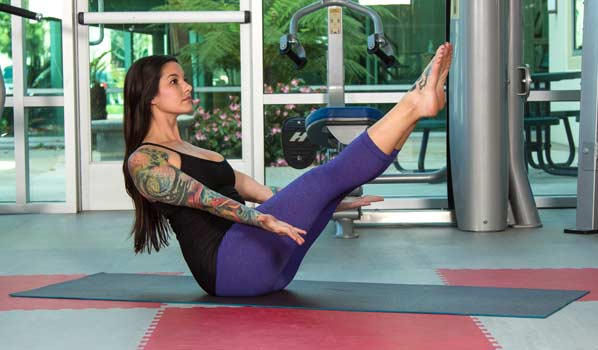Most fitness professionals today agree that incorporating yoga into a training program can yield many benefits. The controversy, however, comes when we start to discuss certain poses, or asanas, and their direct effects on the human body. There are times when clients, due to past injuries or flexibility issues, may not be able to reach the desired pose without further injury. If we keep in mind the particular needs and goals of each client, most yoga poses can be modified and incorporated into a training program. Here are some examples of a few poses that can be a great addition to any fitness program because they build strength and flexibility, and require little modification.
1. Setu Bandha Sarvangasana (Bridge pose)

This pose is great for activating the glutes, which are an important muscle group when it comes to balance, strength and injury prevention. While lying on your back with your knees bent, push your feet into the floor as your raise your hips into the air. It helps to think about squeezing a grape between your glute cheeks, while pushing your heels into the ground so that the glutes fully activate. Make sure you do not hyperextend the hips by raising them too high in the air. This is a great exercise to use as a warm-up to promote stability throughout the trunk. By using this small movement to activate the glutes prior to your workout, your muscles will be prepared to generate adequate force; it may also help in creating muscular balance to prevent injury.
2. Dolphin Pose (puppy pose)

This pose helps to build strength while greatly improving flexibility in the posterior chain, including the back. Starting from a quadruped position, lower your forearms to the floor and push the hips up in the air; work toward straightening the legs. If flexibility issues hinder you from straightening the legs fully, keep the knees bent to your comfort level. To use this as a dynamic flexibility exercise, move fluidly from the quadruped position to the final dolphin pose and back to the quadruped position. To help improve flexibility in the lats, keep pushing the chest back toward the legs. Pushing one heel down toward the ground, and then the other, can also help in increasing flexibility in the calves and mobility in the ankles.
3. Lizard pose

This pose can be used both as a static stretch for isometric conditioning or as a dynamic stretch to warm up before a more strenuous workout. Beginning from an elbow plank position, maintain a strong trunk and bring your right foot up toward your right hand. Depending on your flexibility, you may be able to place your foot down on the outside of your hand. If not, keep working toward that goal and place your foot on the ground where it feels comfortable. Stay in this position while flexing the glutes to increase hip-flexor length, or alternate feet to hand movements to create a more dynamic flow. This pose uses upper-body strength and hip mobility to work the whole body.
4. Navasana (Boat Pose)

Boat pose uses an isometric hold to challenge trunk stability to increase core strength. From a seated position, lean back so your spine is at a 45-degree angle. Keep your feet on the ground with your knees bent and straighten your arms alongside your thighs. Pull the belly button in and up, keeping the core muscles tight and back straight. For more of a challenge, lift the feet off the ground and then straighten the legs. Be sure to maintain tall posture while holding this pose. If held for a short time, boat pose can be used to activate the core muscles before a workout; it can also be used to strengthen the core if held for a longer period of time.
5. Savasana (corpse pose)

Although the corpse pose may not be directly related to increasing flexibility and strength, it is always a great way to end a workout and reflect on the effort that you have just put forth. By lying flat on the ground, after your heart rate has lowered, you are helping to begin the recovery process. Focus on your breath and remember why you are being physically active. Is it for a personal weight-loss goal, event or competition, or to just simply feel better? Use this time to clear your mind from all the stresses of the day and truly enjoy the feeling of being active.
 by
by 









